Did you know stainless steel is made of iron, chromium, and nickel? It’s very durable, used in things like water bottles. But, many people think it can turn green, which isn’t true.
Stainless steel can change color under certain conditions. But it doesn’t turn green like copper or bronze. Knowing this helps us take better care of stainless steel.
Understanding Stainless Steel Composition
Stainless steel is made mainly of iron, chromium, nickel, and sometimes other elements. The key is chromium, which must be at least 10.5%. This chromium content forms a protective layer on the metal’s surface. It greatly improves its resistance to rust and corrosion.
Different grades of stainless steel have unique compositions. This results in various characteristics for different uses. For example, 304 stainless steel has:
| Element | Composition Range |
|---|---|
| Iron (Fe) | 67% – 71% |
| Chromium (Cr) | 18% – 20% |
| Nickel (Ni) | 8% – 12% |
| Manganese (Mn) | ≤ 2% |
| Silicon (Si) | ≤ 0.75% |
| Nitrogen (N) | ≤ 0.10% |
| Carbon (C) | ≤ 0.08% |
| Phosphorus (P) | ≤ 0.045% |
| Sulfur (S) | ≤ 0.03% |
The mix of metals affects the steel’s look and its strength. For example, 304 stainless steel is strong and can stretch a lot. It also has a high melting point of 1450°C.
Stainless steel is better than materials like copper alloys because it doesn’t rust easily. Its special stainless steel composition makes it a top choice in many industries.
What Causes Stainless Steel Discoloration?
Discoloration in stainless steel comes from several factors. Oxidation is a big one. It happens when stainless steel meets air and moisture. This can cause stains and changes in the surface over time.
Heat also plays a part. When stainless steel is welded or heated, the chromium reacts with other elements. This can change the color of the metal, leading to dull spots or discoloration.
Environmental factors are important too. High humidity and oxygen can speed up oxidation. This is especially true in coastal or humid areas, where pollution and temperature affect the metal. Knowing these factors helps prevent discoloration.
Cleaning is key to keeping stainless steel looking good. Washing it with warm water and detergent helps remove impurities. Paint or varnish can also protect it from the elements that cause oxidation.
https://www.youtube.com/watch?v=7uGv360hcsM
Knowing why stainless steel discolors helps us take better care of it. Choosing the right alloy for the job can help it last longer and look better. By addressing these issues early, we can keep stainless steel looking great for a long time.
Does Stainless Steel Turn Green?
Many people wonder if stainless steel can turn green over time. This worry comes from confusion with metals like copper, which can turn green. But, stainless steel usually doesn’t turn green because of its strong makeup and protective qualities.
Common Misconceptions About Green Patina
Some think that touching stainless steel or being outside can make it turn green. But, metals like silver, gold, copper, and palladium can cause a green film. This happens when these metals meet sweat, not on stainless steel.
Stainless steel has at least 10.5% chromium, which helps create a protective layer. Grades like 304 have up to 18% chromium, and surgical grades have even more. Knowing the grade and its makeup can clear up worries about corrosion myths.
Even though stainless steel resists corrosion and tarnishing well, it’s not completely safe. Harsh chemicals, salt water, and high heat can harm its protective layer. This might cause discoloration. To keep stainless steel looking good, proper care practices are key.
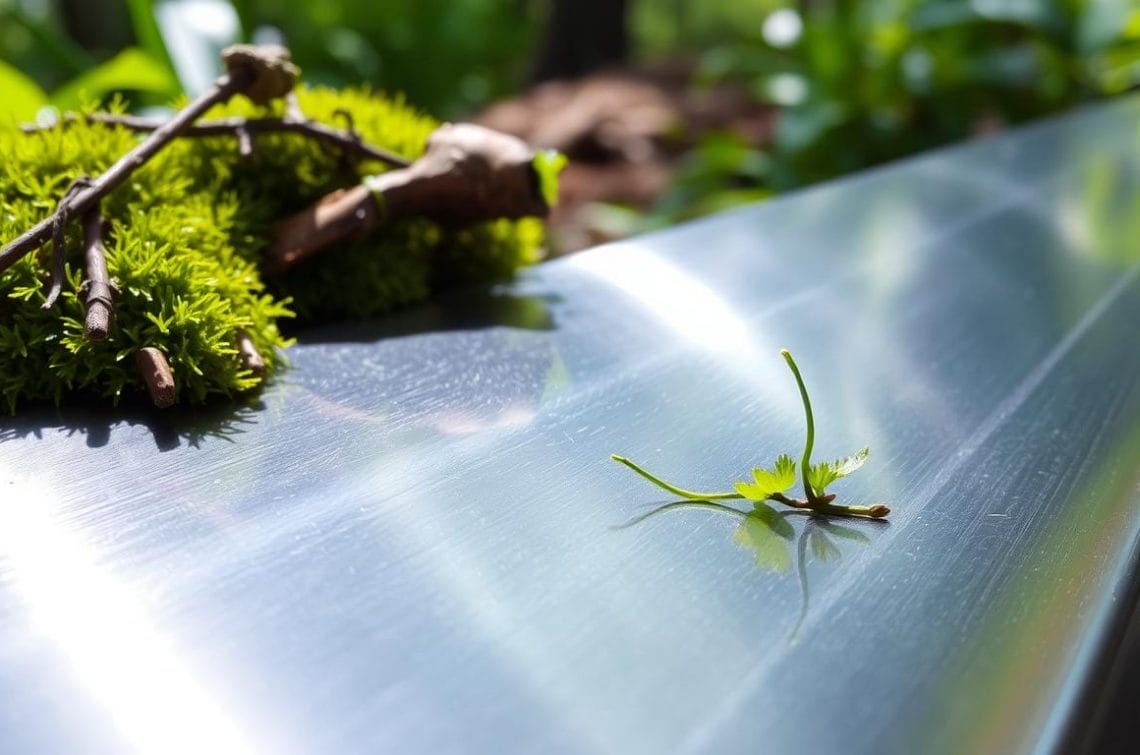
Factors Influencing Stainless Steel Corrosion
Knowing what causes stainless steel to corrode is key to its lasting performance. Stainless steel, rich in chromium, is made to resist corrosion. Yet, harsh conditions can speed up corrosion.
Environmental Conditions and Their Impact
Humidity, temperature changes, and pollutants can speed up corrosion. High humidity leads to faster corrosion due to moisture. Extreme temperatures can also cause corrosion by stressing the material.
These changes can break down the protective layer, leaving the steel open to more damage.
The Role of Chlorides in Corrosion
Chlorides in saltwater or de-icers are a big threat to stainless steel. They can break through the protective layer, causing pitting. Grades like 304 are more at risk in chloride-rich areas.
But, higher alloyed steels like 904L are more resistant. Companies working outdoors should think about chlorides when choosing materials. Regular cleaning can help protect against chloride damage. For tips on keeping stainless steel looking good, check this page.
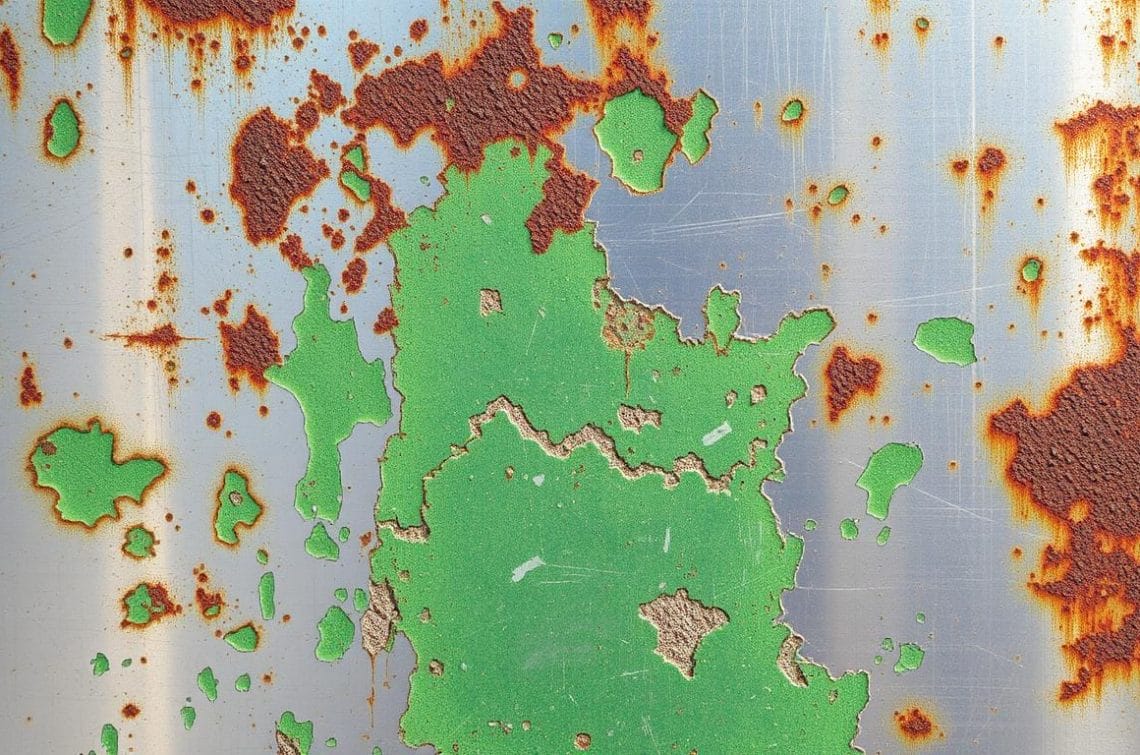
| Stainless Steel Grade | Corrosion Resistance | Key Alloying Elements |
|---|---|---|
| 304 | Moderate | Cr: 18%, Ni: 8% |
| 316 | High | Cr: 16%, Ni: 10%, Mo: 2% |
| 904L | Very High | Cr: 20%, Ni: 25%, Mo: 4% |
| 254 SMO® | Excellent | Cr: 20%, Ni: 18%, Mo: 6% |
| 4307 | Low | Cr: 17%, Ni: 0.5% |
Identifying the Green Patina on Stainless Steel
It’s important to know how to spot green patina on stainless steel. This green color, also called verdigris, can mean there’s corrosion underneath. Checking the affected areas well helps tell if it’s just a stain or real corrosion.
Green patina usually shows up when stainless steel is in damp or high-oxygen places. Knowing that stainless steel has at least 10.5% chromium helps. This chromium fights off corrosion. But, different grades like 201, 304, and 410 have different levels of protection.
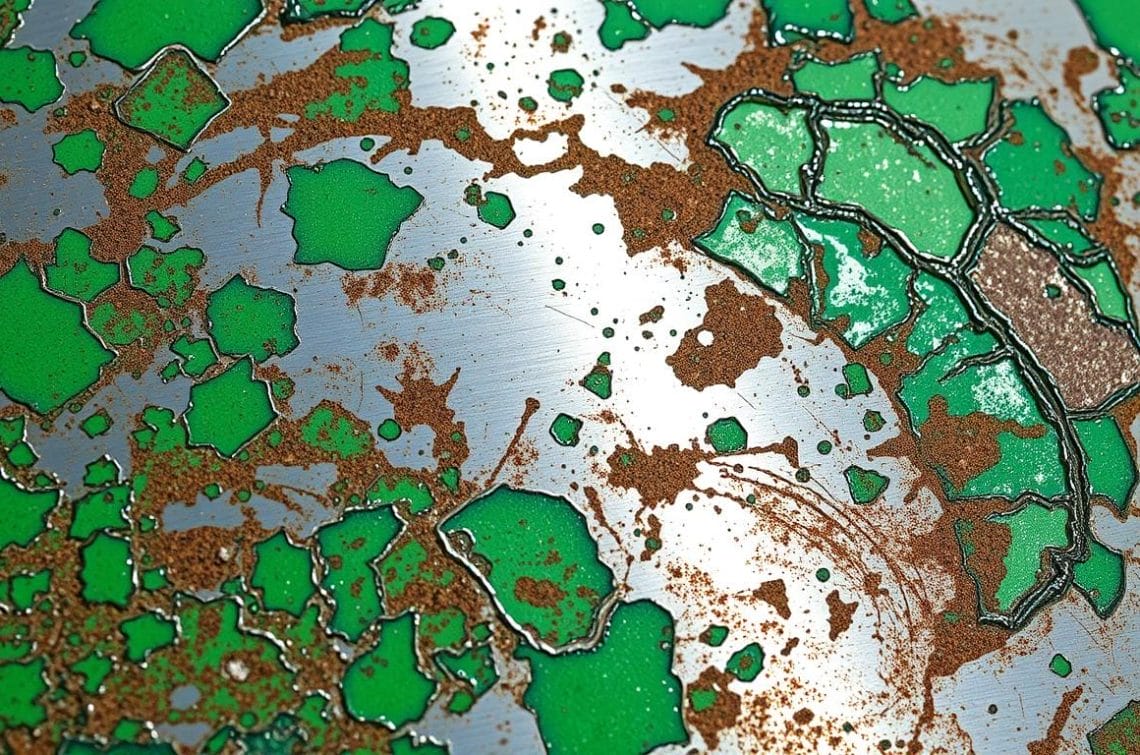
- Look for a clear green color, which might not be even.
- Check for chalky spots, which mean moisture might be causing corrosion.
- Use a magnifying glass to see the surface texture better.
- Also, check nearby metals since they can increase corrosion risk.
Staying ahead of verdigris is key. Regular cleaning helps keep contaminants away. Use special cleaners for stainless steel to avoid harming it.
Being careful and knowing what to look for helps stainless steel last longer. By taking care of it regularly, you can stop corrosion before it starts. This keeps your stainless steel looking good and working well.
How to Prevent Stainless Steel From Turning Green
Keeping stainless steel looking good and lasting long is key. Cleaning it well is a big part of this. By getting rid of dirt and moisture, you protect it from damage.
Regular Cleaning Practices
Cleaning stainless steel regularly is a must. Here are some good ways to do it:
- Rinsing: Always rinse stainless steel surfaces after exposure to water or food residues.
- Drying: Dry surfaces quickly to stop moisture from causing color changes.
- Frequency: Clean often, based on how much you use it, to keep it in top shape.
These steps help block harmful stuff that can make it turn green.
Choosing the Right Cleaning Products
Picking the right cleaner for stainless steel is important. Use gentle cleaners made just for it. Stay away from harsh chemicals to keep the protective layer on. Here’s how to pick the best:
- Choose non-abrasive cleaners to avoid scratches.
- Find cleaners that remove residues without harming the finish.
- Use specialized products for outdoor items to boost protection.
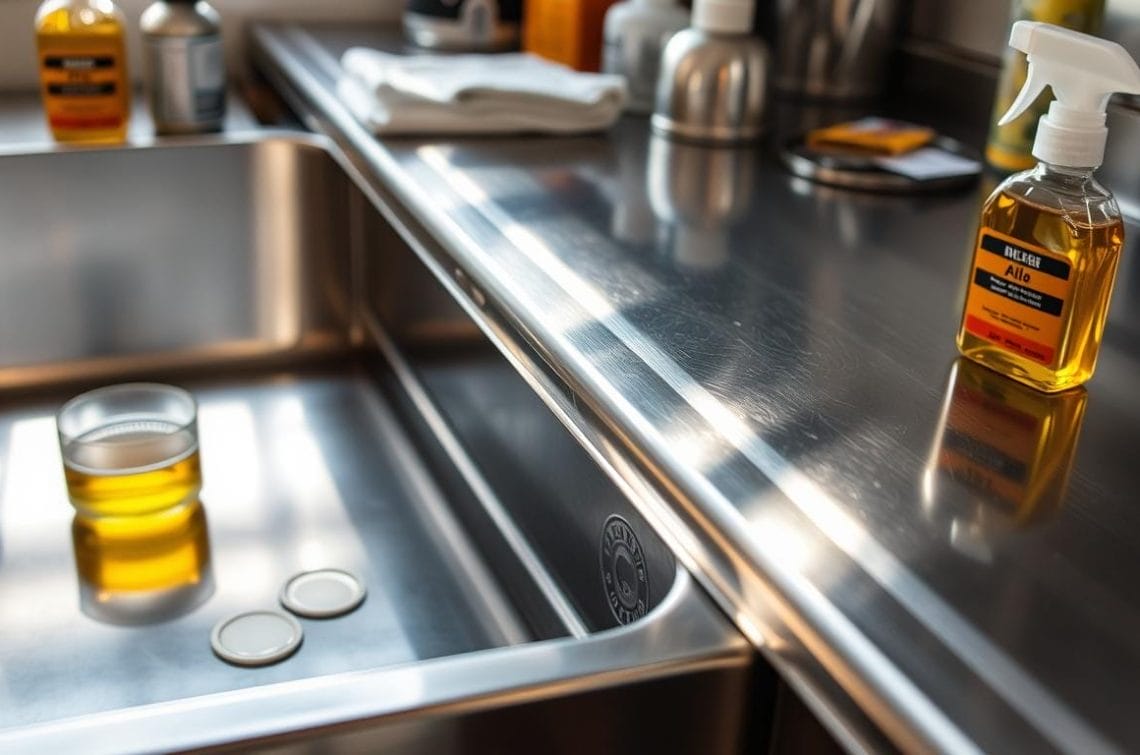
Following these cleaning tips and using the right products will help your stainless steel last longer. It will also keep it looking great.
Stainless Steel Maintenance: Essential Tips
Keeping stainless steel in good shape is key to its long life. Regular checks help spot problems early, like scratches or corrosion. This way, your stainless steel cookware stays in top condition for years.
Routine Inspection for Damage
Checking your stainless steel often is important. It helps find small issues before they get big. Look out for:
- Visible scratches that may expose the metal underneath.
- Signs of rust or tarnishing, often resulting from exposure to harsh chemicals.
- Discoloration due to heat or chemical exposure, indicating a need for urgent action.
By doing regular checks, you can fix problems before they get worse.
Protective Coatings and Treatments
Using protective coatings can make stainless steel last longer. There are special sealants for stainless steel that help prevent tarnishing. These coatings protect against moisture and chemicals. It’s important to know the differences in stainless steel grades:
| Grade | Chromium Content (%) | Tarnish Resistance |
|---|---|---|
| 304 | 18 | Moderate |
| 316 | 16 | High |
| Surgical Grade | Varies (higher than 16) | Very High |
Knowing these details helps pick the best maintenance products. Also, avoid harsh chemicals when cleaning to prevent tarnishing. For more tips, check out safe cleaning methods.
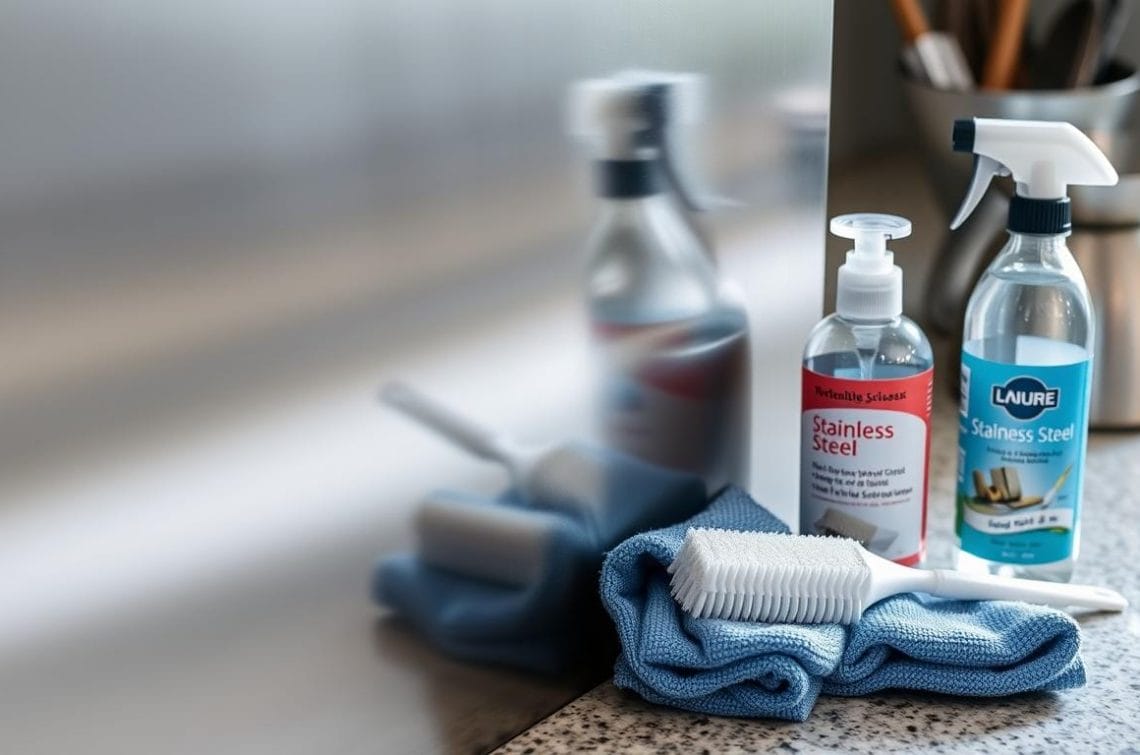
When does Stainless Steel Change Color?
It’s important to know why stainless steel changes color to keep it looking good. Things like chemicals, heat, and the environment can cause it to discolor. The oxidation process is key in these color changes.
Stainless steel jewelry, with at least 10.5% chromium and no more than 1.2% carbon, is more likely to change color. Cleaning it once a month helps. If you don’t keep the chromium layer up, rust can cause discoloration.
Here are some tips to prevent oxidation and keep stainless steel shiny:
- Avoid harsh chemicals like bleach or detergents.
- Keep jewelry in a dry, cool spot to avoid moisture.
- Regularly clean stainless steel to remove dirt.
- Be careful not to expose it to very high temperatures.
Trying to change stainless steel color with laser marking is tricky. Users often struggle to get consistent results. This is because controlling heat and time in the laser process is hard.
Knowing when and why stainless steel changes color helps prevent it. This way, stainless steel items can stay looking as intended for a long time.
Comparing Stainless Steel Grades and Their Resistance
Different stainless steel grades have different levels of corrosion resistance. This is key when choosing materials for cooking, building, or marine use. A resistance comparison of popular grades helps us see which is best for each job.
The most common stainless steel grades include:
- Grade 301
- Grade 304 – Makes up about 50% of global production, with 18% chromium and 8% nickel.
- Grade 316 – Has 2-3% molybdenum, making it great for salty environments.
- Grade 317
- Grade 409 – Resists high temperatures well, often in car exhausts.
- Grade 420 – Used for surgical tools because it resists corrosion well.
- Grade 430 – Used for looks, like car trim.
- Grade 434 – Resists corrosion and can handle up to 1500°F.
It’s important to know the differences between these grades. For example, Grade 316 is better in salty environments than Grade 304. While 304 is very versatile and used a lot, 316 has better resistance to chloride pitting.
| Grade | Key Features | Typical Applications |
|---|---|---|
| 304 | 18% Cr, 8% Ni; excellent corrosion resistance | Kitchen appliances, cutlery, architectural paneling |
| 316 | 16-18% Cr, 10-14% Ni, 2-3% Mo; superior resistance to corrosion | Marine environments, chemical processing, pharmaceuticals |
| 409 | High-temperature oxidation resistance | Automotive exhaust systems |
| 420 | High corrosion resistance; used for surgical instruments | Surgical tools, cutlery |
Grade performance depends on chemical makeup, cost, and where it’s used. Grade 316 has more nickel and molybdenum, making it better in tough conditions than 304. Knowing about these stainless steel grades helps us choose the right one for our needs.
Common Mistakes in Stainless Steel Care
Stainless steel care mistakes can cause serious damage and shorten the life of appliances. One big mistake is using abrasive cleaners. These can scratch the surface, making it look dull and old. It’s important to use cleaners that are gentle to keep the finish looking good.
Another mistake is not cleaning in the right direction. Cleaning against the grain can push dirt deeper into the metal, causing scratches. Cleaning the right way is key to keeping stainless steel in good shape. Regular cleaning also helps keep the protective layer on the metal, which prevents corrosion.
Leaving things in the sink can also be a problem. It can cause stains and streaks that are hard to get rid of. It’s best to clean up spills right away with a damp cloth or paper towel. This helps avoid the need for deep cleaning later.
Using harsh chemicals like chlorine and bleach is a big no-no. They can create pits in the surface that trap dirt, making cleaning harder. Also, cleaning with hard water can leave spots. Drying stainless steel with a soft cloth right after washing can prevent these spots.
To better understand the cleaning pitfalls and mistakes to avoid, check out the table below:
| Common Mistakes | Consequences | Recommended Practices |
|---|---|---|
| Using abrasive cleaners | Scratches and dull appearance | Use mild dish soap or specialized cleaners |
| Wiping against the grain | Increased dirt trapped and scratches | Wipe along the natural grain |
| Leaving items in the sink | Stains and difficult-to-remove streaks | Clean spills immediately |
| Using harsh chemicals | Surface pitting and trapped contaminants | Avoid chlorine and bleach |
| Cleaning with hard water | Spots and potential streaking | Dry immediately with a soft cloth |
| Neglecting regular maintenance | Grime build-up requiring intensive cleaning | Routine wiping with a damp microfiber cloth |
Knowing about these common mistakes can help you take better care of stainless steel products. With the right knowledge, your appliances can stay in top shape for many years.
Real-life Examples of Stainless Steel in Outdoor Settings
Stainless steel is great for outdoor use because it’s tough and looks good. Many examples show how well it holds up with the right care. It’s used in railings, furniture, and sculptures that last long and look great.
A coastal area had stainless steel railings installed. They faced salty air but showed little corrosion. This is because of the high chromium in the steel. Regular upkeep helped them last longer.
Outdoor sculptures made from duplex stainless steel are also impressive. They’re strong and don’t corrode easily. Cleaning them with soap and water keeps them looking good. Additionally, their sleek and modern appearance makes them a popular choice for public installations, blending durability with aesthetic appeal. The art of south work metal has made it possible to craft intricate designs that remain strong against the elements. Over time, these sculptures become cherished landmarks, showcasing the perfect harmony between creativity and engineering.
Powder-coated stainless steel furniture is also popular outdoors. It comes in many colors and lasts a long time. But, it needs regular cleaning to stay looking new.
| Application Type | Material Type | Key Benefits | Maintenance Tips |
|---|---|---|---|
| Railings | Austenitic Stainless Steel | High corrosion resistance, aesthetic value | Regular cleaning and inspection |
| Sculptures | Duplex Stainless Steel | Excellent strength, weather resistance | Periodic assessments for oxidation |
| Furniture | Powder-Coated Stainless Steel | Variety of colors, superior durability | Clean with mild soap weekly |
These examples show how versatile and strong stainless steel is outdoors. Choosing the right type and caring for it is key. This way, it looks and lasts well in many places.
Addressing Common Concerns and Myths
Many stainless steel concerns come from wrong ideas about its properties and how to care for it. Some think stainless steel never corrodes. But, it’s not true. It’s very durable and resistant, but harsh conditions can still affect it.
There are over 150 types of stainless steel, each with its own level of resistance. For example, 304 and 316 grades are better for certain uses because they have 18% and 16% chromium, respectively.
It’s important to clear up myths for people. Some think wearing stainless steel jewelry means no skin problems. But, it’s not always true. Prolonged contact with moisture or sweat can cause skin to turn green. This happens because of the acids in our skin reacting with the metal.
Keeping stainless steel products clean and stored properly is key. Regular cleaning helps keep the protective layer from getting damaged. Companies like The Cary Company offer durable stainless steel products. They help clients understand how to take care of them.
Here’s a table with important facts about stainless steel and common myths:
| Myth/Fact | Truth |
|---|---|
| Stainless steel is impervious to corrosion | Stainless steel can corrode under harsh conditions. |
| All stainless steel is the same | There are over 150 grades with varying properties. |
| Stainless steel jewelry never tarnishes | Skin reactions can occur due to the metal alloys used. |
| Maintenance is unimportant | Routine care is crucial to longevity. |
| Cheap stainless steel is safe | Lower-quality grades can contain reactive metals. |
The Importance of Proper Stainless Steel Care
Proper care of stainless steel is key to keeping it in top shape. By following a regular maintenance routine, you can make your stainless steel last longer. This means less chance of it getting damaged or corroded.
Cleaning and handling stainless steel right keeps it looking good. It also makes it last longer. This is important for homes and businesses alike.
Stainless steel’s value is huge, especially in places where it might get damaged. For example, 304 stainless steel is great for the food industry. Meanwhile, 316 is better for areas with lots of chlorides.
By cleaning and protecting stainless steel, you prevent it from getting dirty or discolored. This keeps it looking new for a long time.
Stainless steel’s durability comes from its own properties and how we take care of it. Regular upkeep and the right cleaning methods help it last longer. This saves money and is better for the environment.
FAQ
Does stainless steel turn green?
What causes stainless steel discoloration?
How can I prevent stainless steel from turning green?
Can environmental conditions cause stainless steel corrosion?
How do I identify a green patina on stainless steel?
What are the best practices for stainless steel maintenance?
Why does stainless steel change color?
What are the differences between stainless steel grades?
What common mistakes should I avoid in stainless steel care?
What are some examples of stainless steel in outdoor settings?
Source Links
- https://splitflask.com/blogs/news/are-stainless-steel-water-bottles-safe?srsltid=AfmBOory6QAGbLXLQzTv39JG6uyZfGawl2Ogj5_3BMSQLKL18oK4ZNSj
- https://innovatodesign.com/blogs/featured/stainless-steel-jewelry-pros-and-cons?srsltid=AfmBOophROfwdfIwooexJG7Bi3OiXi1oYTP1DqwXIAMGPRoapzlYlDM9
- https://www.blickman.com/understanding-stainless-steel
- https://atoleajewelry.com/blogs/waterproof-jewelry-blog/does-stainless-steel-turn-green-on-skin?srsltid=AfmBOopUgXiilkNCVQju5MutJ1KekrFh2fOAZ0hxKPRoOvNEjmdmKlqk
- https://www.huaxiao-ss.com/does-stainless-steel-turn-green.html
- https://www.sswm.com.au/why-does-my-stainless-steel-have-an-unsightly-brown-discolouration/
- https://tampasteel.com/does-stainless-steel-turn-green/
- https://www.thecarycompany.com/insights/articles/does-stainless-steel-turn-green?srsltid=AfmBOopyuNbOkdGgXIaEuQNCuYP1P0H4o1CUOE01BHCf5uxJJKeaWThY
- https://www.outokumpu.com/en/expertise/stainless-basics/corrosion-resistance
- https://mrssteel.com.vn/blogs/steel-blog/top-5-factors-of-stainless-steel-corrosion-and-most-effective-preventi
- https://steelprogroup.com/stainless-steel/properties/
- https://chcmetal.com/does-stainless-steel-turn-green/
- https://cometopollensa.com/2020/11/28/how-to-avoid-that-green-stuff-on-your-stainless-steel-jewelry/
- https://www.thecarycompany.com/insights/articles/does-stainless-steel-turn-green?srsltid=AfmBOorW_rqRqdB6ZZSIuwD8a4BCcuNzGiQTht62Sc9Adz_z0zOerfpu
- https://steelprogroup.com/stainless-steel/maintenance/green/
- https://www.thecarycompany.com/insights/articles/does-stainless-steel-turn-green?srsltid=AfmBOop4qVE917Rf5ArAbbSOufJOWmZDZnITVoeglpXfYiOtFFNrHqxA
- https://www.thecarycompany.com/insights/articles/does-stainless-steel-tarnish?srsltid=AfmBOoq1JcOckwEcukVFLQCsyPUeqzC8a5IURbmTZZYZtvdL51UmFEKd
- https://artizanjoyeria.com/blogs/news/pros-and-cons-of-stainless-steel-jewelry?srsltid=AfmBOoqOTOSpqK4pgSK1_OdJAa_l3a561Px_E-atLlXsayBk9p0lzX5f
- https://forum.lightburnsoftware.com/t/colors-on-stainless-steel/106200
- https://www.kloecknermetals.com/blog/a-short-guide-to-grades-of-stainless-steel/
- https://www.xometry.com/resources/materials/18-8-vs-316-vs-304-stainless-steels/
- https://www.ruvati.com/t-304-vs-t-316-grade-stainless-steel/
- https://learn.compactappliance.com/stainless-steel-cleaning-mistakes/
- https://greenssteel.com/blogs/news/top-6-mistakes-to-avoid-when-cleaning-stainless-steel-coffee-tumblers?srsltid=AfmBOoqt7YwynCmJr1mwREjEshC2I9rRy51ejsTnRhq01TgMUX1rhmq2
- https://www.microfiberwholesale.com/blogs/blog/ultimate-stainless-steel-cleaning-guide
- https://www.kloecknermetals.com/blog/does-stainless-steel-rust/
- https://www.unifiedalloys.com/blog/powder-coating-stainless-steel
- https://tutco.com/blog/ask-ian-stainless-steel-temperatures
- https://www.thecarycompany.com/insights/articles/does-stainless-steel-turn-green?srsltid=AfmBOooW_HdxeZIIMnTxYBpfHoYkZrQOxBvMdOofQlwYnzb2f3DH6lrk
- https://www.pandkjewelry.com/blog/why-stainless-steel-jewelry-turns-skin-green/
- https://www.unifiedalloys.com/blog/stainless-environmental-benefits
- https://www.thecarycompany.com/insights/articles/does-stainless-steel-tarnish?srsltid=AfmBOop5DsF3MhUX7N5cwgQXWcq2G_8y0FG6CM2qbs53bUTP40Cr7kQV






